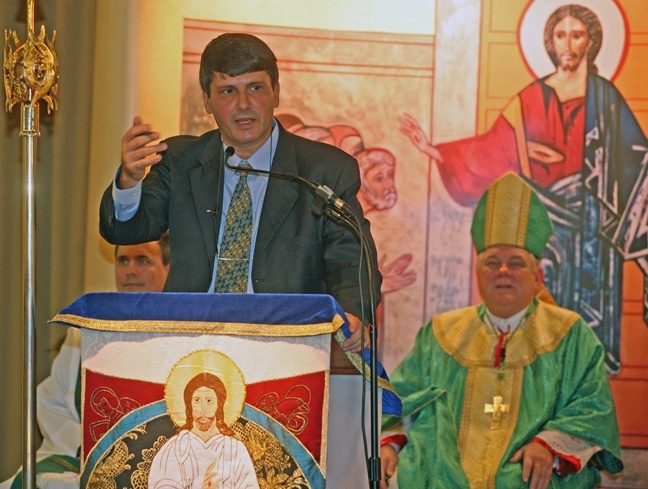By Marlene Quaroni - Florida Catholic

Photographer: MARLENE QUARONI | FC
Stefano Benigni, director of the Neocatechumenal Way in Florida, addresses the congregation after Mass.
FORT LAUDERDALE � Attending Sunday Mass during the Saturday evening vigil is one of the ways members of the Neocatechumenal Way practice their charism.
�It�s a way to keep youth and others with the Lord and not at parties on Saturday night,� said Francisco Tobon of Mother of Christ Church in Miami, a member of the community for the past 24 years. �On Sunday, families get together for devotion.�
The weekend of Oct. 22-23, about 300 members of the movement from throughout Florida met in Fort Lauderdale, the largest number since the annual retreats began.
The Neocatechumenal Way dates back to 1964, to the work of artist and musician Francisco �Kiko� Arguello and lay missionary Carmen Hernandez in the slums of Palomeras Altas, Madrid, Spain. They began to proclaim the Gospel of Jesus Christ to the poor with whom they were living.
�The preaching was founded on what is called the tripod: Word of God-Liturgy-Community, that seeks to lead people to fraternal communion and mature faith,� said Tobon.
 Because the Neocatechumenal Way began among the poor where organs and pianos were not available, Mass musicians play mostly string instruments, such as guitars, wind instruments, like flutes, and bongo drums. �Una Gran Se�al,� a hymn by Arguello honoring the Virgin Mary, is sung after Mass.
Because the Neocatechumenal Way began among the poor where organs and pianos were not available, Mass musicians play mostly string instruments, such as guitars, wind instruments, like flutes, and bongo drums. �Una Gran Se�al,� a hymn by Arguello honoring the Virgin Mary, is sung after Mass.
The Neocatechumenal Way emerged as a grass-root offspring of the renewal of the Second Vatican Council. The Way is implemented in small, parish-based communities of between 20 and 50 people. There are about 40,000 communities in the world, with an estimated one million members.
�Italy and Spain have the most number of communities,� said Tobon.
Some liturgical concessions have been granted to the Neocatechumenal Way, including: moving the Rite of Peace to before the consecration, receiving Communion with unleavened bread rather than hosts, and receiving Communion while standing in place rather than going up to the priest or eucharistic minister.
The Neocatechumenal Way is deeply committed to the �New Evangelization� called for by Pope John Paul II. The Way also runs 75 �Redemptoris Mater� diocesan missionary seminaries around the world and is responsible for hundreds of �Families in Mission� worldwide.
�There are 36 communities in Florida in 13 different parishes,� said Tobon. �Those at the retreat are the leaders of the communities that came from the Archdiocese of Miami, the dioceses of Orlando and Venice. In the Miami Archdiocese there are communities at Mother of Christ, St. Joachim, Our Lady of Lourdes, St. James, St. Jerome, St. Vincent and San Lazaro.�
Members of the Neocatechumenal Way in Florida gave Archbishop Thomas Wenski a silver cross, a symbol of the mission entrusted to them.
�To be a Christian, to follow Jesus along his Way, is not a burden but a gift, and to make him known to others is a joy,� the archbishop said in his homily.
Following Mass, Stefano Benigni, leader of the Neocatechumenal Way in Florida and a member of the Miami archdiocese�s Tribunal staff, asked unmarried men to stand up if they felt the Church was calling them to the priesthood. Unmarried women interested in joining religious orders, and families interested in missionary work, also were asked to stand.
�The Catholic Church is a missionary Church,� Benigni said as he wrote down the names, ages and number of children among the married couples who stood up.
In the 40 years since its inception, the Neocatechumenal Way has given many fruits to the Church; many vocations to priesthood, religious life and many lasting conversions. Despite occasional criticism from priests, theologians and local bishops, both John Paul II Pope Benedict XVI have given the movement their blessing and fully approved their teaching and practices.
During an event in St. Peter�s Basilica to mark the 40th anniversary of the official founding of the Neocatechumenal Way, Pope Benedict addressed 25,000 members of the movement.
�How can we not bless the Lord for the spiritual fruits which, through the methodology of evangelization that you apply, have been harvested in these years,� he said. �How many fresh apostolic energies have risen up both among priests and among lay people. How many men and women and how many families that had grown distant from the ecclesial community or had abandoned the practice of Christian life, through the announcement of the kerygma and the itinerary of rediscovery of baptism, have been helped to find again the joy of the faith and the enthusiasm of the testimony of the Gospel.�
 This article has been corrected since it was initially posted.
This article has been corrected since it was initially posted.
�It�s a way to keep youth and others with the Lord and not at parties on Saturday night,� said Francisco Tobon of Mother of Christ Church in Miami, a member of the community for the past 24 years. �On Sunday, families get together for devotion.�
The weekend of Oct. 22-23, about 300 members of the movement from throughout Florida met in Fort Lauderdale, the largest number since the annual retreats began.
The Neocatechumenal Way dates back to 1964, to the work of artist and musician Francisco �Kiko� Arguello and lay missionary Carmen Hernandez in the slums of Palomeras Altas, Madrid, Spain. They began to proclaim the Gospel of Jesus Christ to the poor with whom they were living.
�The preaching was founded on what is called the tripod: Word of God-Liturgy-Community, that seeks to lead people to fraternal communion and mature faith,� said Tobon.

Photographer: MARLENE QUARONI | FC
Cecilia Eyerman, left, of St. Jerome Parish in Fort Lauderdale, joins others in dancing to the Neocatechumenal Way's hymn, "Una Gran Se�al."
Arguello, Hernandez and Father Mario Pezzi, of the Archdiocese of Rome, form �the international responsible team of The Way�, the Neocatechumenal leadership. Statutes describe the nature of The Way and regulate its charism and specific tasks within the Church.
The Neocatechumenal Way emerged as a grass-root offspring of the renewal of the Second Vatican Council. The Way is implemented in small, parish-based communities of between 20 and 50 people. There are about 40,000 communities in the world, with an estimated one million members.
�Italy and Spain have the most number of communities,� said Tobon.
Some liturgical concessions have been granted to the Neocatechumenal Way, including: moving the Rite of Peace to before the consecration, receiving Communion with unleavened bread rather than hosts, and receiving Communion while standing in place rather than going up to the priest or eucharistic minister.
The Neocatechumenal Way is deeply committed to the �New Evangelization� called for by Pope John Paul II. The Way also runs 75 �Redemptoris Mater� diocesan missionary seminaries around the world and is responsible for hundreds of �Families in Mission� worldwide.
�There are 36 communities in Florida in 13 different parishes,� said Tobon. �Those at the retreat are the leaders of the communities that came from the Archdiocese of Miami, the dioceses of Orlando and Venice. In the Miami Archdiocese there are communities at Mother of Christ, St. Joachim, Our Lady of Lourdes, St. James, St. Jerome, St. Vincent and San Lazaro.�
Members of the Neocatechumenal Way in Florida gave Archbishop Thomas Wenski a silver cross, a symbol of the mission entrusted to them.
�To be a Christian, to follow Jesus along his Way, is not a burden but a gift, and to make him known to others is a joy,� the archbishop said in his homily.
Following Mass, Stefano Benigni, leader of the Neocatechumenal Way in Florida and a member of the Miami archdiocese�s Tribunal staff, asked unmarried men to stand up if they felt the Church was calling them to the priesthood. Unmarried women interested in joining religious orders, and families interested in missionary work, also were asked to stand.
�The Catholic Church is a missionary Church,� Benigni said as he wrote down the names, ages and number of children among the married couples who stood up.
In the 40 years since its inception, the Neocatechumenal Way has given many fruits to the Church; many vocations to priesthood, religious life and many lasting conversions. Despite occasional criticism from priests, theologians and local bishops, both John Paul II Pope Benedict XVI have given the movement their blessing and fully approved their teaching and practices.
During an event in St. Peter�s Basilica to mark the 40th anniversary of the official founding of the Neocatechumenal Way, Pope Benedict addressed 25,000 members of the movement.
�How can we not bless the Lord for the spiritual fruits which, through the methodology of evangelization that you apply, have been harvested in these years,� he said. �How many fresh apostolic energies have risen up both among priests and among lay people. How many men and women and how many families that had grown distant from the ecclesial community or had abandoned the practice of Christian life, through the announcement of the kerygma and the itinerary of rediscovery of baptism, have been helped to find again the joy of the faith and the enthusiasm of the testimony of the Gospel.�

Photographer: MARLENE QUARONI | FC
Guitarists play during the Neocatechumenal Way Mass.
Powered by 
This site is protected by reCAPTCHA and the Google Privacy Policy and Terms of Service apply
